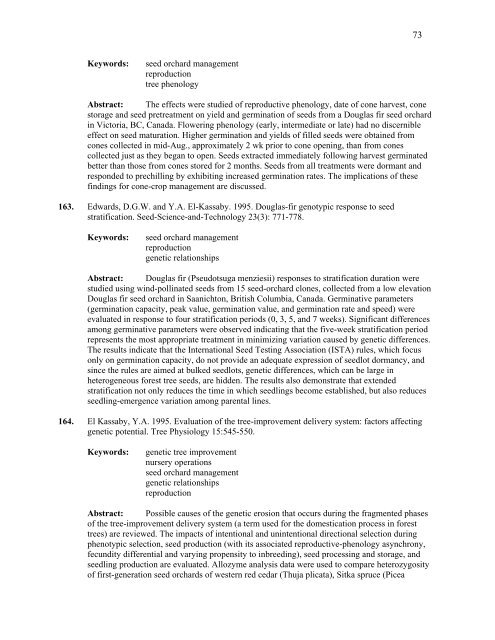IntensIve sIlvIculture - Forest Science Labs - Research Network ...
IntensIve sIlvIculture - Forest Science Labs - Research Network ...
IntensIve sIlvIculture - Forest Science Labs - Research Network ...
You also want an ePaper? Increase the reach of your titles
YUMPU automatically turns print PDFs into web optimized ePapers that Google loves.
Keywords: seed orchard management<br />
reproduction<br />
tree phenology<br />
Abstract: The effects were studied of reproductive phenology, date of cone harvest, cone<br />
storage and seed pretreatment on yield and germination of seeds from a Douglas fir seed orchard<br />
in Victoria, BC, Canada. Flowering phenology (early, intermediate or late) had no discernible<br />
effect on seed maturation. Higher germination and yields of filled seeds were obtained from<br />
cones collected in mid-Aug., approximately 2 wk prior to cone opening, than from cones<br />
collected just as they began to open. Seeds extracted immediately following harvest germinated<br />
better than those from cones stored for 2 months. Seeds from all treatments were dormant and<br />
responded to prechilling by exhibiting increased germination rates. The implications of these<br />
findings for cone-crop management are discussed.<br />
163. Edwards, D.G.W. and Y.A. El-Kassaby. 1995. Douglas-fir genotypic response to seed<br />
stratification. Seed-<strong>Science</strong>-and-Technology 23(3): 771-778.<br />
Keywords: seed orchard management<br />
reproduction<br />
genetic relationships<br />
Abstract: Douglas fir (Pseudotsuga menziesii) responses to stratification duration were<br />
studied using wind-pollinated seeds from 15 seed-orchard clones, collected from a low elevation<br />
Douglas fir seed orchard in Saanichton, British Columbia, Canada. Germinative parameters<br />
(germination capacity, peak value, germination value, and germination rate and speed) were<br />
evaluated in response to four stratification periods (0, 3, 5, and 7 weeks). Significant differences<br />
among germinative parameters were observed indicating that the five-week stratification period<br />
represents the most appropriate treatment in minimizing variation caused by genetic differences.<br />
The results indicate that the International Seed Testing Association (ISTA) rules, which focus<br />
only on germination capacity, do not provide an adequate expression of seedlot dormancy, and<br />
since the rules are aimed at bulked seedlots, genetic differences, which can be large in<br />
heterogeneous forest tree seeds, are hidden. The results also demonstrate that extended<br />
stratification not only reduces the time in which seedlings become established, but also reduces<br />
seedling-emergence variation among parental lines.<br />
164. El Kassaby, Y.A. 1995. Evaluation of the tree-improvement delivery system: factors affecting<br />
genetic potential. Tree Physiology 15:545-550.<br />
Keywords: genetic tree improvement<br />
nursery operations<br />
seed orchard management<br />
genetic relationships<br />
reproduction<br />
Abstract: Possible causes of the genetic erosion that occurs during the fragmented phases<br />
of the tree-improvement delivery system (a term used for the domestication process in forest<br />
trees) are reviewed. The impacts of intentional and unintentional directional selection during<br />
phenotypic selection, seed production (with its associated reproductive-phenology asynchrony,<br />
fecundity differential and varying propensity to inbreeding), seed processing and storage, and<br />
seedling production are evaluated. Allozyme analysis data were used to compare heterozygosity<br />
of first-generation seed orchards of western red cedar (Thuja plicata), Sitka spruce (Picea<br />
73
















